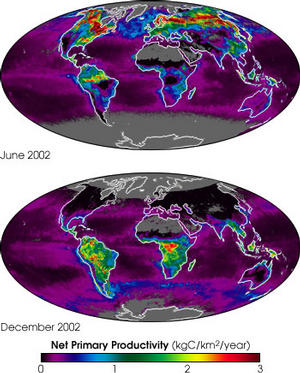| The Earth's Carbon Metabolism | 2003-04-25 19:34 1 comment |
 by Flemming Funch by Flemming FunchNASA announced that it has a couple of satellites that are helping to continuously map the Earth's 'metabolism'. They track the rate at which plant life is absorbing carbon (from carbon dioxide) out of the atomosphere. That shows the productivity of the Earth's carbon cycle. The rate of carbon fixation through photosynthesis is a basic property of life on planet Earth. It is the basis for capturing and storing the energy that fuels our world’s living systems and forms the foundation of the food webs. The oxygen we breathe is a byproduct of this photosynthesis. According to its creators, these new net primary productivity maps provide a fascinating new insight into the intimate connection between the living world and the physical world.Notice that a lot of the productivity is in the oceans. About half of the total. Interesting to see those maps. It all isn't entirely in the areas I would have expected. A whole lot going on in Canada, Sweden, Siberia, and in the North Sea. |